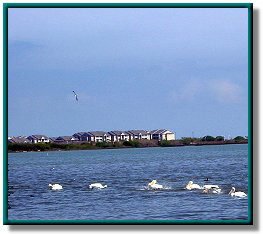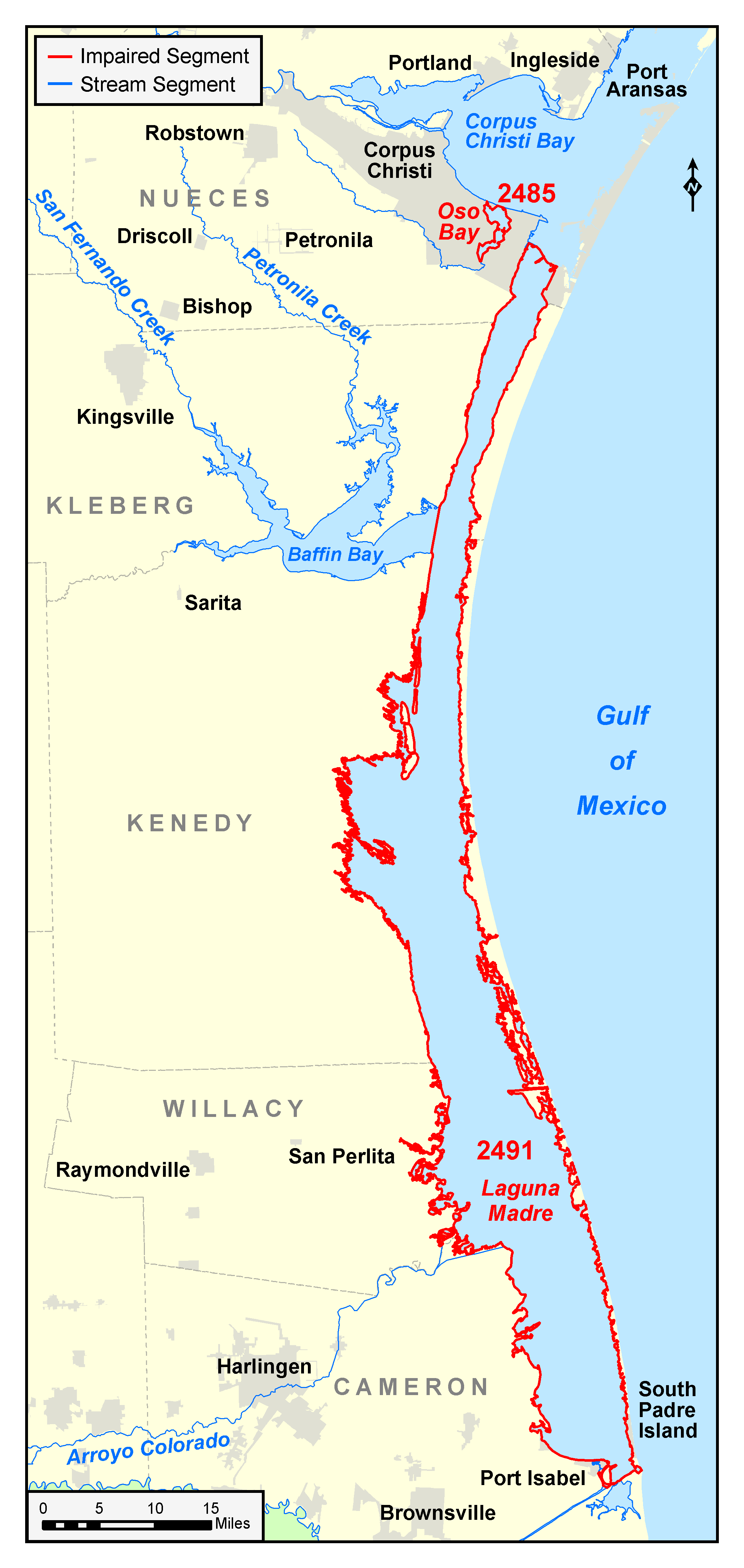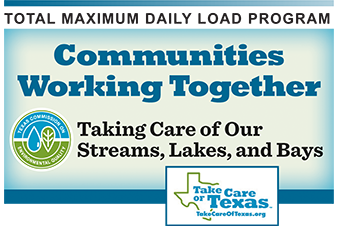Oso Bay and the Laguna Madre
Counties: Cameron, Kenedy, Kleberg, Nueces, Willacy
Parameter: Dissolved oxygen
Basins: Bays and Estuaries, San Antonio–Nueces Coastal, Nueces River, Nueces–Rio Grande Coastal
Segments: 2485, 2491
On this page:
- Water Quality and Watershed Description
- Status
- Public Participation
- Data and Assessment Reports
- Contact the TMDL Program
Water Quality and Watershed Description
In 2000, water quality testing found that concentrations of dissolved oxygen in Oso Bay and the Laguna Madre are sometimes lower than the criterion established to assure a healthy aquatic ecosystem. Oxygen, which dissolves in water, is essential for the survival of aquatic life. While the amount of dissolved oxygen in water fluctuates naturally, various human activities can cause unusually or chronically low dissolved-oxygen levels which may harm fish and other aquatic organisms.
Oso Bay is an enclosed, shallow body of water situated along the southern shore of Corpus Christi Bay, with a surface area of approximately seven square miles. The bay receives fresh water from Oso Creek, a stream whose flow is dominated by permitted discharges, and exchanges salt water with Corpus Christi Bay. Ecologically, Oso Bay provides habitat for many plants and animals, and plays an influential role in water purification and storm protection.
The Laguna Madre, which drains most of the Nueces-Rio Grande Coastal Basin, is one of only five hypersaline estuaries in the world. The Laguna is a shallow, bar-built coastal lagoon with limited freshwater inflow and a surface area at mean high tide of 729 square miles. The Arroyo Colorado is primarily responsible for freshwater inflow to the lower Laguna Madre. The Laguna is generally hypersaline, with barren shorelines and extensive wind-tidal flats, extensive submerged seagrass meadows, and a highly productive fishery. The shorelines of the Laguna Madre are mostly inaccessible because of large tracts of privately owned ranch land and two federally protected areas—Padre Island National Seashore and Laguna Atascosa National Wildlife Refuge.
Status
Assessment Results
TCEQ’s TMDL Program assessed concentrations of dissolved oxygen and their effect on aquatic life in the two water bodies in 2001 and 2002. The results indicated that low dissolved oxygen levels are a consistent problem, but are probably due to natural conditions. So, TCEQ decided that it was most appropriate to carry out a use attainability analysis (UAA) rather than develop a total maximum daily load (TMDL).
Many water bodies are evaluated against a general set of standards that are applied to all water bodies, regardless of local conditions. These are called "presumed standards." A UAA establishes uses and criteria that are appropriate for a specific water body, taking into account the unique features of the local ecosystem and watershed.
Revisions to Water Quality Standards
Based on the completed UAAs, in 2010, TCEQ proposed revisions to the site-specific standards for dissolved oxygen in the Oso Bay. The EPA rejected those revisions, saying they were not well enough supported by the documentation. Accordingly, the TCEQ Standards Work Group then assessed and analyzed conditions further. In 2014 and 2018, TCEQ adopted and submitted new proposed revisions to change the dissolved oxygen criteria for assessing the aquatic life use Oso Bay, Upper Laguna Madre, and Blind Oso Bay. EPA approved the revisions for Oso Bay, Blind Oso Bay, and Oso Creek. Approval is still pending on the revisions for the Upper Laguna Madre. Email the Standards Work Group for more information about the basis and the status of the Standards revisions.
Public Participation
In all its projects, TCEQ gathers information from stakeholders—people who live or work in the watershed. The stakeholder committees of the Coastal Bend Bays and Estuaries Program (CBBEP) provided the participation forum for this project. These committees include representatives from state and federal agencies, industries, citizen groups, local governments, universities, water districts, agricultural interests, environmental groups, and other water user groups.
Data and Assessment Reports
- Water Quality and Biological Characterization of Oso Creek and Oso Bay, Corpus Christi, Texas
- Oso Bay and Laguna Madre Phase III and IV Data Report
Contact the TMDL Program
Please email tmdl@tceq.texas.gov and mention the Oso Bay and Laguna Madre project in the subject line. Or call us at 512-239-6682. For more information about the Standards revisions, email standards@tceq.texas.gov or call them at the same phone number.






 Back to top
Back to top